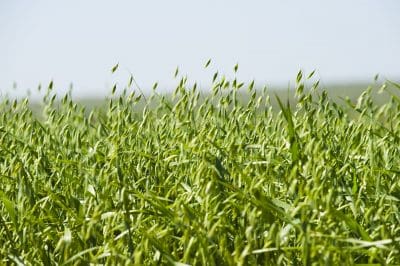OATS growers in Western Australia are just weeks away from harvesting record hectares of a potentially high-yielding crop that has taken full advantage of an ideal season.
The only issue tempering expectations has been the steady slide in market values since sowing where the price for oats has fallen from new season levels at the start of the year of $300/tonne to currently around $200/t.
Premium Grain Handlers manager, John Orr, North Fremantle, said the oat price at the start of the season reflected an oat shortage which the West had experienced for the past couple of years.
“Growers have responded to that and have planted a bigger crop. On top of that we have had a very good season, so we are expecting both the quality and quantity to be favourable now,” he said.
“That is expected to cause the supply to increase beyond the rising demand. Demand is going up around 15 per cent a year, but it looks like the supply has gone up much more than that, which it needed to do. So prices have come back to reflect a comfortable supply situation.
“We are expecting the customers (buyers) to load up on that while it is at the lower levels.”
Full moisture profile
ConsultAg consultant, Garren Knell, Northam, said most oat-growing regions had had average to above-average rainfall this season and were going into spring with a full soil moisture profile.
“We have a big crop, certainly a record for the past 10 years. But it has coincided with a 30 per cent drop in price,” he said.
“Most of the crop is in early head emergence because a lot of people had the opportunity to get oats in early this season. Harvest will be late October for the early crops, but most will be in November.”
Get our free daily cropping news straight to your inbox – Click here
Mr Knell said the area sown to oats had been increasing in WA over the past couple of years, with a sharp spike this year.
Where the crop had traditionally only been grown in the western areas of the WA wheatbelt, heightened interest, particularly from new growers, had seen it pushing out into the more marginal and drier wheat-growing areas.
Asian demand
The increased plantings were driven by high early prices, an expanding local processing sector and heightened demand from Asia.
“We have seen Asian markets grow rapidly, wanting to source high beta-glucan oats. Where traditionally Asian countries would have a fried rice-type breakfast they are now having Asian-flavoured porridges,” Mr Knell said.
“Traditionally in WA the oat market was mainly centred around the Japanese racehorse industry as well as the local stockfeed industry, with a little bit of milling thrown in.”
The processing sector in WA has seen rapid expansion in the past couple of years with Quaker Oats investing in new facilities to process more oats in WA and Victorian-based Unigrain purchasing Morton Seed and Grain’s oat processing facility.
In addition, WA’s main grain handler, CBH, has recently announced it will construct a multi-million-dollar oat processing plant at the Metro Grain Centre in Perth with potential to process 60,000 tonnes of WA oats.
This follows CBH’s acquisition last year of one of Australia’s largest oat suppliers, Blue Lake Milling, that has processing plants in South Australia and Victoria.
Frost tolerance
Mr Knell said oats was a popular crop among growers for its advantages in the cropping cycle, particularly its frost tolerance.
“We regularly get frost damage in our wheat, sometimes in our barley, whereas oats is a very tolerant crop. We have had a few frosts this year which did a little bit of damage, but not widespread,” he said.
“And oats tend to be grown earlier in the season and grow a big canopy which competes with the weeds, resulting in less reliance on herbicides to manage weeds.
“With wheat, we have to sow it late to try to avoid frosts, whereas oats can be sown early, maximising yield and maximising their competitive nature against weeds.”
Mr Knell said there had been outbreaks of Septoria and oat rust in some varieties this season that farmers were applying fungicide strategies to control.


HAVE YOUR SAY